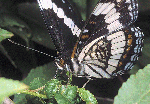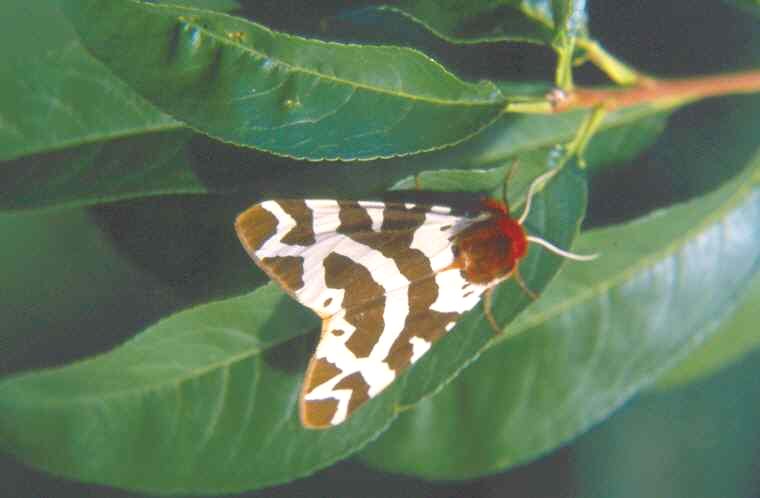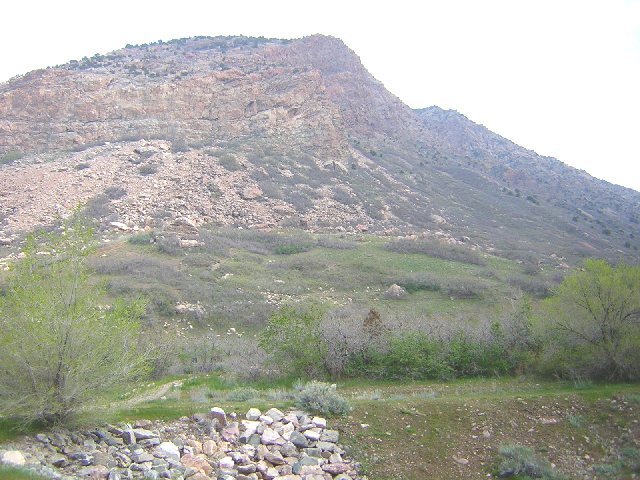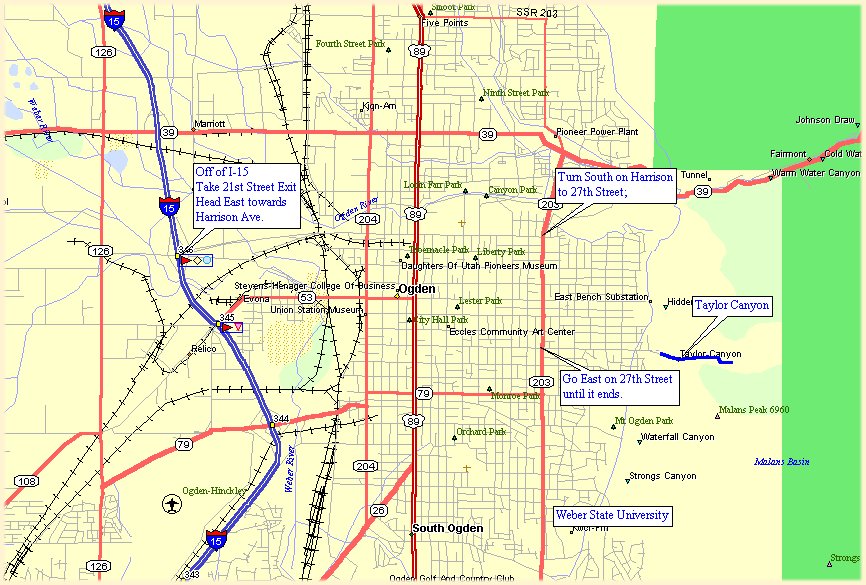
Utah Lepidopterists' Society
Founded 6 Nov 1976

|
|
Utah Lepidopterists' Society Founded 6 Nov 1976 |
|
| History | Mission | Meetings | Bulletin | Checklists | Links | Community | Field Trips | Habitat | Members | Kids | Contact Us |
Utah Habitats for Butterflies and Moths
Wasatch Canyons--Taylor Canyon in Ogden
 |
8. Montane 9. Utah's Dixie |

Nestled just to the East of Weber State University and downtown Ogden, Taylor Canyon offers a wide variety of activities for naturalists from rock climbing to collecting butterflies and moths. Like other Wasatch Front Canyons, Taylor Canyon is a dry canyon with males of many species of butterflies patrolling up and down the dry wash and nearby road.
| During March, some of the species you may find flying on a sunny, 50+ degree days include some of our overwintering nymphalids such as Nymphalis antiopa (mourning cloak), Nymphalis milberti furcillata (milbert's tortoiseshell), Nymphalis californica (california tortoiseshell), and Polygonia satyrus satyrus (satyr comma). Towards the end of March, Pontia protodice (checkered white) flies accompanied soon thereafter by the very common moth, Litocala sexsignata; which becomes quite abundant in the canyon. |
During the warmth of mid-April, several butterfly species of swallowtails, blues, and whites emerge, also begin to fly. These species include Papilio zelicaon nitra (anise swallowtail), Pontia sisymbri sisymbri (spring white), Anthocharis stella browningi (utah stella orangetip) Euchloe ausonides coloradensis (large marble), Colias philodice eriphyle (yellow sulphur), Glaucopsyche lygdamus oro (silvery blue) and Phyciodes mylitta mylitta (thistle crescent). Because of the extensive outcropping of rocks in nearby cliffs in Taylor Canyon, the Utah Stella Orange-tip flies well because of the many species of Arabis that grow there. In some isolated pockets of the canyon, in mid-April, one can also find populations of Callophrys sheridani neoperplexa (sheridan's green hairstreak).
Towards the end of April, skippers such as Erynnis brizo burgessi (sleepy duskywing), Erynnis telemachus (rocky mountain duskywing) and Hesperia juba (juba skpper) start flying. Another species that starts flying in early May, whose males do fly right along the road are Papilio multicaudata pusillus (two-tailed swallowtail).
During 2004 and 2005 adults of Nathalis iole (dainty sulphur) migrated into the canyon from the south. It is not known if these migrants breeded in the area to produce another generation. The closest known larval host (that I know of) for Nathalis iole would be Bidens cernua growing in the vicinity of Willard Bay.
A special note about the spring white (Pontia sisymbri sisymbri) You need to climb a little to some of Taylor Canyon's trails along the side of the mountain to find males of this butterfly ascending towards the top. As you do so, you may find a few males of the Anise Swallowtail (Papilio zelicaon nitra,) behaving similarly.
Populations of Pontia sisymbri sisymbri (spring white) and Euchloe ausonides coloradensis (large marble) thrive in Taylor Canyon and Farmington Canyon. An interesting fact that might contribute to this is that larvae of these butterflies are using the invasive Isatis tinctoria (dyar's woad), as a larval hostplant. Similar populations of these butterflies in Salt Lake County may not be as plentiful as dyar's woad is rare or absent there. (Of course, those butterflies use other mustards such as Cardaria draba, Descurainia pinnata and Arabis sparsiflora.) Anthocharis stella browningi (utah stella orangetip) does not seem to have adapted to use Isatis tinctoria (dyar's woad) as a natural larval hostplant in Taylor Canyon; although larvae accept and feed on it in the lab. This might indicate that dyar's woad has not been prevalent in the canyon for very long and that the orangetips have not yet adapted to use it. (It is also interesting to note that Anthocharis sara populatons from the Rogue River region of Josephine County, Oregon have adapted to use dyar's woad as a natural larval hostplant.)
Other species that start flying in early May, whose males do fly right along this dry canyon are the Two-tailed Swallowtail (Papilio multicaudata pusillus,) Melissa Blue (Plebejus melissa melissa,) Sagebrush Checkerspot (Chlosyne acastus acastus,) Field Crescent (Phyciodes pulchella camillus.) If you look along some of the hiking/biking trails of Taylor Canyon, you will also occasionally run into Euphydryas anicia maria (Variable Checkerspots) as well as Everes amyntula (Western Tailed Blue.)
Towards the end of May, other species that may start flying along the canyon is the Western Tiger Swallowtail (Papilio rutulus rutulus,) Gray Hairstreak (Strymon melinus franki,) Coronis Fritillary (Speyeria coronis snyderi,) Callippe Fritillary (Speyeria callippe harmonia,) Painted Lady (Vanessa cardui,) Red Admiral (Vanessa atalanta rubria,) Weidemeyer's Admiral (Limenitis weidemeyeri latifascia,) and the Common Ringlet (Coenonympha tullia brenda.)
During the month of June, other species of fritillaries begin to fly such as the Great Basin Fritillary (Speyeria egleis utahensis,) Northwestern Fritillary (Speyeria hesperis wasatchia,) which fly along with the Northern Crescent (Phyciodes cocyta.)
Butterfly Species Checklist For Taylor Canyon:
Swallowtails (Family Papilionidae)
|
Brush-footed Butterflies (Family Nymphalidae)
|
Gossamer-wing Butterflies (Family Lycaenidae)
|
Milkweed Butterflies (Family Danaidae)
|
Skippers (Family Hesperiidae)
|
Whites and Sulphurs (Family Pieridae)
|
All images of Limenitis weidemeyeri on the ULS Info Bar courtesy Jay Cossey
|
|